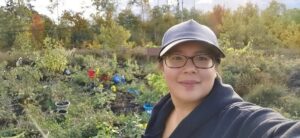Dreaming of growing season: Atikameksheng woman cultivating arts, food sovereignty space

By Laura E. Young
ATIKAMEKSHENG ANISHNAWBEK— Aside from the watermelon she was able to grow in the wilds of Northern Ontario, Manidoo Bineshiihn marvels that local deer didn’t wreak havoc with her gardens.
The deer were frequent visitors. Bears came, too, but didn’t demolish her crops either.
The watermelon was delicious.
“It didn’t grow to be a huge watermelon that you could get at the grocery store. But I was surprised that I was able to grow it, pick it and eat it,” says Bineshiihn, the founder of a collective arts and food sovereignty space on her family’s land in Atikameksheng Anishnawbek.
When the Coronavirus-19 pandemic shut down the world, Bineshiihn’s career in the film industry dried up. Like so many others, she turned to gardening – in her case, on a grand scale.
“Losing my job really connected me to my art and created a new passion for me to learn how to provide for my family, not just through land-based living, but through farming organic foods,” she says.
She set to moving soil and seeds in the spring of 2020, naming the space and her vision Manidoo Bineshii Dreams.
“It is an Indigenous-led space. This is where you can learn and reconnect with your mind, body, and soul.”
Manidoo Bineshii Dreams’ space is rooted in the traditional territory of the Robinson-Huron 1850 treaty lands west of the Sudbury, Ont., neighbourhood of Lively.
The site is nestled on a small parcel of land along the Panache Lake Road Highway. She has an edible forest with 17 fruit trees. She purchased five trees, while the remainder were donated. The cedar was donated at her grandfather’s memorial.
After her grandfather passed in 2021, she dedicated a cherry tree to him. Some of his ashes from the ceremony were used to make a sacred tree, she adds.
“That was done in his honour because he came to my site on a regular basis to help motivate me going and see the progress.”
In 2021, she planted seeds for the first time.
“They say to plant more in case you don’t succeed,” she says. “Everything came up. Nothing died. So, I ended up having an overabundance of tomatoes and dill. I had way too much spinach and kale. I had to give away plants because I had too many.”
She also grew tobacco.
“It was a huge success. The fortunate thing was being able to provide this to Elders and community members for their traditions.”
The property is open, with the various small sheds and containers tucked to the side. A cobblestone pathway lined with various plants from hostas and tobacco to lilacs. She found the recycled cobblestones online.
“I really wanted to create that pathway into the entrance of the garden to provide a welcome to all.”
In addition to beds of tomatoes, watermelon, basil, and strawberries, she planted what she calls her Three Sisters Garden, which are three large mounds, brimming with corn, beans, and squash.
Last fall, she turned them into garlic beds where she planted three different kinds of garlic.
“I probably planted 100 garlic bulbs. The thing about the garlic beds that’s so important to me is this is the main medicine I use for my own immune system.”
She also wants to provide space for historical teachings to show there is a positive path and way to live.
As she plans her garden for 2022, Bineshiihn is also looking ahead to scheduling workshops. Last summer, Jessica Niemi, an artist from Lively, led two eco-printing workshops.
Ultimately, Bineshiihn plans to host writing, painting, beading, and more eco-printing workshops as part of the vision for the arts collective space.
“The arts collective is really important to the space because I really want to support local artisans. I want artisans to practise and perfect their craft.”
For now, the work to achieve Manidoo Bineshii Dreams has been hers alone.
“It is a tough road but I want to see where it goes,” she reflects. “I’ve seen the work I’m doing change lives. Whether it be a minor change in somebody to think about how they’re living their life and how they can be more eco-friendly, or how they can help these communities that are living in poverty.”
It’s about reconnecting to self and protecting the land and water, she says.
She draws her dedication to revitalizing culture from her mother’s line, the advocacy for land and water rights from her father’s line.
“And making sure I don’t forget who I am and where I come from but making it something we can value today. And just providing for the seven generations that have passed and the seven generations to come.”
She ponders the future for her nieces and nephews.
“I’m driven every day by the DNA that flows within me. Whether I want to give up, there’s no giving up.”
As for the deer, she believes the sense of an open space convinced the deer they could come and go freely.
“I believe they come in to look around and spend time in the garden. This was their space before I was there. Being able to still have access to that space is that reciprocal relationship as beings as we’re both living in this world together.”


